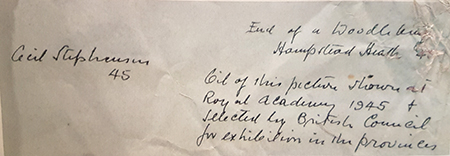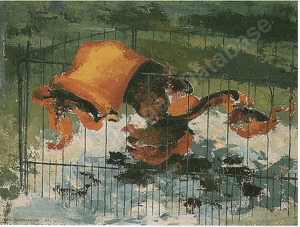

 Hover over the painting to magnify (there may be an initial delay while the magnified image is loaded)
Hover over the painting to magnify (there may be an initial delay while the magnified image is loaded)John Cecil Stephenson (1889-1965):
The End of a Doodlebug, Hampstead Heath, 1945
Framed (ref: 2609)
Signed and dated, Inscribed by the artist on the reverse in pen and ink: ‘End of a Doodlebug Hampstead Heath.
Chalk and pastel over pencil and pen and ink
10 x 14 in. (25.5 x 35.5 cm)
See all works by John Cecil Stephenson chalk ink pastel pen and ink pencil Canney Abstract Art still lifes topography war World War II Paintings by British Artists
Provenance: The Artist’s family

Exhibited: WW2 - War Pictures by British Artists, Morley College London, 28 October -23 November 2016, cat 39.

Literature: Simon Guthrie, John Cecil Stephenson, Cartmel Press Associates, 1997, p. 148. WW2 - War Pictures by British Artists, Edited by Sacha Llewellyn & Paul Liss, July 2016, cat 39, page 77.
Oil of this picture shown at Royal Academy 1945 & selected by British Council for exhibition in the provinces.'
The
V-1, developed by the German Luftwaffe during the SecondWorldWar, was
the first guided missile used in war and the forerunner of today’s
cruise missile. Between June 1944 and March 1945, it was fired at
targets in London and Antwerp. The simple pulse-jet engine pulsed fifty
times per second, and the characteristic buzzing sound gave rise to the
colloquial name of doodle-bug (after an Australian insect).
This
picture depicts the remnants of a doodlebug, which Stephenson (whose
Hampstead studio was damaged during the Blitz in 1940) saw on the Heath
in 1945.The picture was exhibited at the Royal Academy that year (cat.
no. 96)
and subsequently went on tour with the British Council.
Stephenson made his first abstract paintings around 1932. In 1934 he exhibited with the 7 & 5 Society, along with Ben and Winifred Nicholson, Ivon Hitchens, Henry Moore, Barbara Hepworth and John Piper. Though not today as well known as many of his contemporaries he was one of the key figures in the development of abstract art in Britain. Indeed Herbert Reed noted that Stephenson 'was one of the earliest artists in this country to develop a completely abstract style' and credited him with being the father figure of the 'gentle nest of artists' (Ben and Winifred Nicholson, Barbara Hepworth and Henry Moore) who occupied the Mall Studio's in Hampstead. At the beginning of WW2 Calder and Mondrian counted amongst his friends and were frequent visitors to The Mall Studios.

Piet Mondrian photographed in a Hampstead garden by John Cecil Stephenson 1939
Estate of John Cecil Stephenson/Tate Archive
During World War Two, as preparation for larger works (materials being in short supply), Stephenson worked on a series of small studies in oil on card. They were stimulated by the devastation resulting from the bombing of London (also recorded figuratively by Stephenson during this period). In the following decade some of the designs were later realized as larger oils.
 British Abstract Art
British Abstract Art SOLD
SOLD




